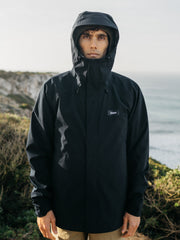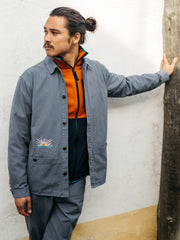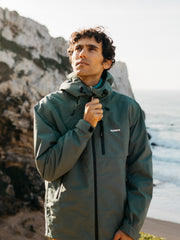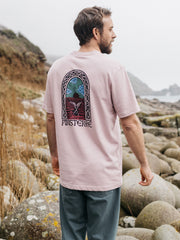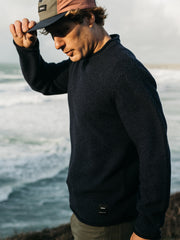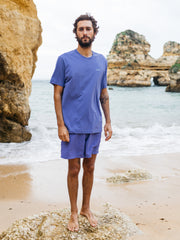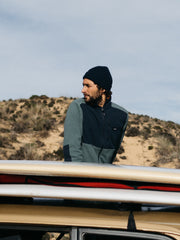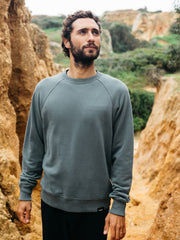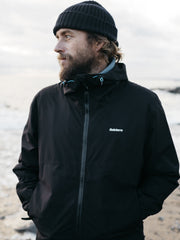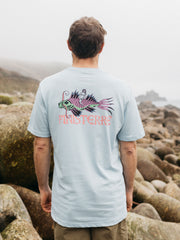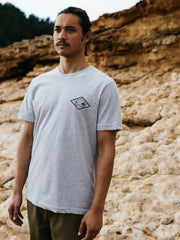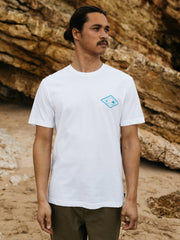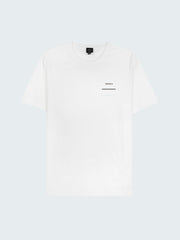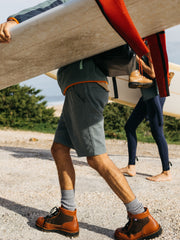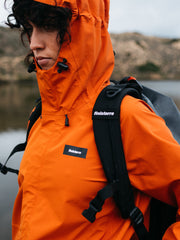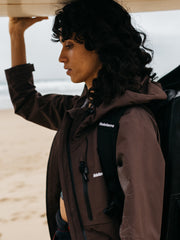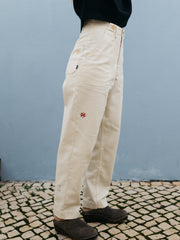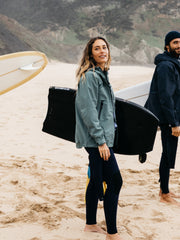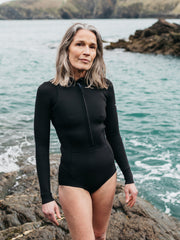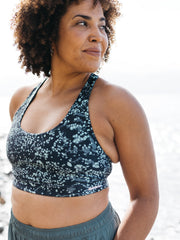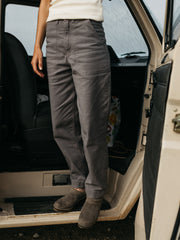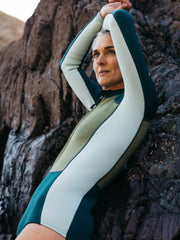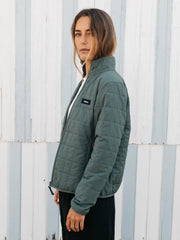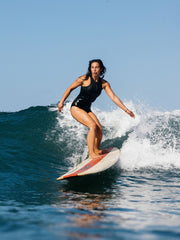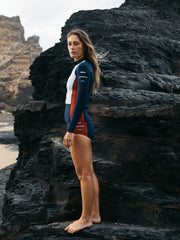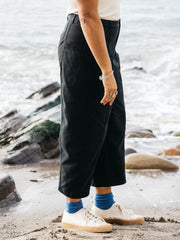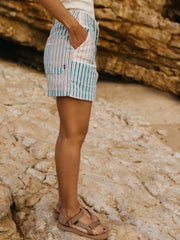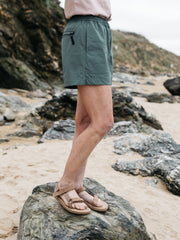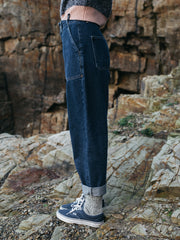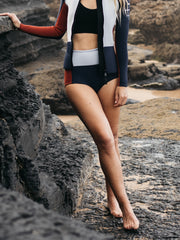Momentarily suspended between water and air, time and face, there’s nothing quite like stripping away the clutter and indulging in the timeless pleasures of bodysurfing. London Surf / Film Festival director and passionate ‘womper’ Demi Taylor explores why.
The Lightness Of Being
07.18.18
4 min read
The glassy surface laps around my shoulders, the warmth of the long days has lingered in the swirling currents just enough to have liberated me from my neoprene. Through a haze of salt heavy lashes I scan the glittering horizon for just one more wave, my hand shading my eyes as if in salute to the setting sun. A deep blue furrow signals an approaching set and I turn shoreward, waiting. The wave crests, feathering and I’m cast into shadow, a moment’s pause, an inhalation then, kick, kick, kick, reach, go. Holding my breath, just for a second I’m suspended in time and face, then unleashed, racing down the line, left arm outstretched, body taught as the wave chases me down. Sunlight refracts through the crystalline water as the lip begins to curl overhead and my view pinwheels into ever decreasing circles, before the lip finally detonates into a fizzing mass – white water, ozone. I tumble fins over head, part of the wave, until the maelstrom dissipates, releasing me from its grip and I surface, laughing to myself, swimming back out for just one more.
The Origins
Bodysurfing is as old as the notion of surfing itself. In essence, it is the act of harnessing the energy of the ocean to propel yourself forth – whether in pursuit of simple pleasure, or in pursuit of a surfboard. It was always an integral part of the great waveriding tradition. Simply put, it is surfing in the most elemental of terms; stripped back to its barest form, without any clutter or distraction.
“I’m always trying to find the most immediate, the most real, raw way of being connected to nature, whatever that may be,” explains freediver and ocean conservationist Hanli Prinsloo. ‘Bodysurfing really shares that purity that freediving offers, just you, your body, your ability and the ocean.”
Before the late 1970s, anyone who surfed regularly was by necessity a bodysurfer. Chasing your board, retrieving it before willing waves or waiting cliff faces converted it into matchsticks was just an accepted element of the all-round waterman or woman’s arsenal. And then, with the advert of the leash, it began a steady retreat to the margins – to the shallow edges and shorelines for the uninitiated and to screaming, deep pockets of fast, wedging waves for the quietly committed.
The Master
I first met Mark Cunningham in Ireland in 2001. Bundoran was playing host to the World Masters Surfing Contest and a who’s who of icons were in town to compete, from the two Tom’s – Carroll and Curren – to Rabbit, Kanga, Kong, The Sultan of Speed and The Wounded Seagull, and Simon Anderson riding his game-changing Thruster. And there was Mark – lifeguard from Ehukai Beach Park, running water safety. We spent a lay day in the infamous Bridge Bar, trading tales and talking surfing.
With broad shoulders and a broader smile, he talked in yet broader brush stokes about 25 years spent guarding on the North Shore – nonchalant, sincere, humble. It was only after Mark left that one of the assembled legends leant over and explained to me, with a certain reverence, that I’d just been in the company of the godfather of modern bodysurfing, a man who dominated at Pipeline for some 20 years scooping every title going, setting the template in the style stakes. Quietly committed. And that was my first lesson in bodysurfing – that there’s no room and no need for ego, and it’s a lesson that’s doled out whenever I swim out: body surfers are not at the top of the pecking order, and that’s OK.
The Lessons
“Bodysurfing will never be the ‘cool’ thing to do,” says film director, Tim Burnham, whose multi award-winning documentary Dirty Old Wedge shines a light on the hard charging, fearless crew who dominate Newport Beach’s infamous break. “I think most respect those who can bodysurf well, while not really understanding how or why people do it. If you're bodysurfing for any other reason than it being fun and a challenge, then you're missing the point.”
Speaking with Mark about what it is about bodysurfing that keeps him coming back for more, “it simply feels good”, he says, with his typical demystifying underplay. “I get exercise, I get to go outdoors, I see my friends, and I’m completely surrounded and immersed in Mother Nature.”
Traditional bodysurfing was all about proning shoreward, straight and true, within the mass of a broken wave, arms tucked against the body, with your head leading the way – streamlined, like a dolphin riding the swell lines. Then stand-up surfers discovered the trim, and naturally everything changed, bodysurfing became about the pocket, planing and the open face.
“Being fully immersed, feeling the pull of the tides and currents on my body, has taught me about rips and about truly reading the ocean, without relying on the floatation offered by a board to get me out of trouble.”
I came to bodysurfing though a back injury that had left me and my surfboard dry-docked. I saw it as a way back in – a saline lifeline. But it turned out to be so much more than just a substitute; it has been a real education. Being fully immersed, feeling the pull of the tides and currents on my body, has taught me about rips and about truly reading the ocean, without relying on the floatation offered by a board to get me out of trouble.
It’s given me greater awareness – noticing who is around me and who has priority has real implications. It’s opened me up to a whole community of wavesliders and introduced me to some of my greatest friends. It’s shown me how to cut down on hefty surf travel expenses – you can always, always, always fit a pair of fins in your hand luggage. It’s pushed me out of my comfort zone, and shown me that sometimes when it comes to waves, bigger can be better. And it’s taught me that sometimes you just have to commit.
The Secret
“Bodysurfing is ultimately you and a pair of fins,” says surfer and writer Chris Nelson. “Whether you’re riding big or small waves, you have to put yourself on the peak and under the lip, taking off on the most critical part. You can’t try and take off on the shoulder, you need to stay in the hook, the powerful part of the wave – because you don’t have the drive that a surfboard gives you. If you think about it – your hand becomes the nose of your board and your fin becomes the tail – the trick is to keep the line between the two as pure as possible.”
There’s a liberating lightness that comes from the stripped back nature of bodysurfing, untethered from boards and expectations. “For me, it takes the performance aspect out and just feels like play,” explains Easkey Britton, a lifelong surfer who regularly charges some of Ireland’s most challenging waves. “It’s a mix of reconnecting with an activity that felt so natural and instinctual as a kid and yet it also feels new to me now as an adult.”
So what’s the key? Speaking to Mark Cunningham again recently about the secret of bodysurfing, he says it comes down to five golden rules. “1) Be a strong swimmer. 2) Make sure your suit is going to stay on. 3) Kick like hell. 4) Keep your arms in front of you to prevent head and neck injuries. 5) Come out of the water smiling.”
“I like to think of it as wave play. Being lifted and carried by the energy of a wave, with a sense of gliding and total immersion. It’s a full-body experience and total connection with the wave. It feels much more intimate and often more liberating than the other forms of surfing which rely on equipment.”
- Easkey Britton
“Get a good pair of fins that you can rely on. Know your limits and abilities. Start small and work your way into bigger surf. Commit at take-off and don't hesitate. Most importantly look before you drop in on a wave and never assume someone isn't going to make it! ”
- Tim Burnham, director, Dirty Old Wedge
“Suddenly you’re suspended between worlds – you’re somehow in the water and somehow not and it’s the sense of flying, skidding down the face of the wave, and after having that sensation of, ‘Did that really just happen? Did I really just become part of the ocean’s energy?’ That for me is the feeling of bodysurfing; becoming part of the ocean’s energy and then be suspended in this sort of state of flying.”
- Hanli Prinsloo


